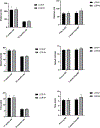Mitochondria Transplantation: Rescuing Innate Muscle Bioenergetic Impairment in a Model of Aging and Exercise Intolerance
- PMID: 38900170
- PMCID: PMC11192236
- DOI: 10.1519/JSC.0000000000004793
Mitochondria Transplantation: Rescuing Innate Muscle Bioenergetic Impairment in a Model of Aging and Exercise Intolerance
Abstract
Arroum, T, Hish, GA, Burghardt, KJ, Ghamloush, M, Bazzi, B, Mrech, A, Morse, PT, Britton, SL, Koch, LG, McCully, JD, Hüttemann, M, and Malek, MH. Mitochondria transplantation: Rescuing innate muscle bioenergetic impairment in a model of aging and exercise intolerance. J Strength Cond Res 38(7): 1189-1199, 2024-Mitochondria, through oxidative phosphorylation, are crucial for energy production. Disease, genetic impairment, or deconditioning can harm muscle mitochondria, affecting energy production. Endurance training enhances mitochondrial function but assumes mobility. Individuals with limited mobility lack effective treatments for mitochondrial dysfunction because of disease or aging. Mitochondrial transplantation replaces native mitochondria that have been damaged with viable, respiration-competent mitochondria. Here, we used a rodent model selectively bred for low-capacity running (LCR), which exhibits innate mitochondrial dysfunction in the hind limb muscles. Hence, the purpose of this study was to use a distinct breed of rats (i.e., LCR) that display hereditary skeletal muscle mitochondrial dysfunction to evaluate the consequences of mitochondrial transplantation. We hypothesized that the transplantation of mitochondria would effectively alleviate mitochondrial dysfunction in the hind limb muscles of rats when compared with placebo injections. In addition, we hypothesized that rats receiving the mitochondrial transplantation would experience an improvement in their functional capacity, as evaluated through incremental treadmill testing. Twelve aged LCR male rats (18 months old) were randomized into 2 groups (placebo or mitochondrial transplantation). One LCR rat of the same age and sex was used as the donor to isolate mitochondria from the hindlimb muscles. Isolated mitochondria were injected into both hindlimb muscles (quadriceps femoris, tibialis anterior (TA), and gastrocnemius complex) of a subset LCR (n = 6; LCR-M) rats. The remaining LCR (n = 5; LCR-P) subset received a placebo injection containing only the vehicle without the isolated mitochondria. Four weeks after mitochondrial transplantation, rodents were euthanized and hindlimb muscles harvested. The results indicated a significant (p < 0.05) increase in mitochondrial markers for glycolytic (plantaris and TA) and mixed (quadricep femoris) muscles, but not oxidative muscle (soleus). Moreover, we found significant (p < 0.05) epigenetic changes (i.e., hypomethylation) at the global and site-specific levels for a key mitochondrial regulator (transcription factor A mitochondrial) between the placebo and mitochondrial transplantation groups. To our knowledge, this is the first study to examine the efficacy of mitochondrial transplantation in a rodent model of aging with congenital skeletal muscle dysfunction.
Copyright © 2024 National Strength and Conditioning Association.
Figures





References
MeSH terms
Grants and funding
LinkOut - more resources
Full Text Sources
Medical

